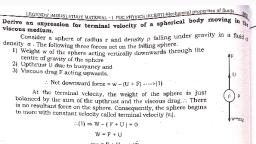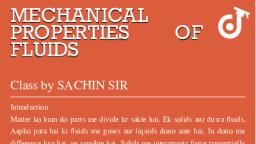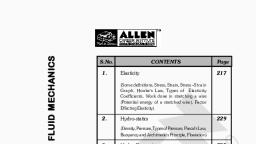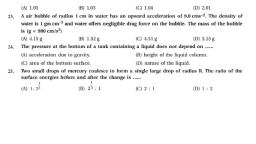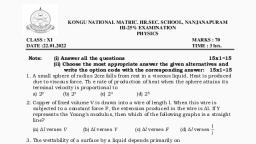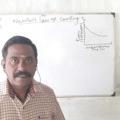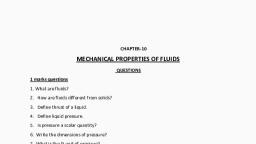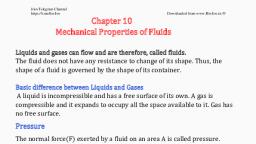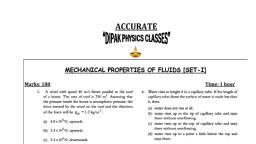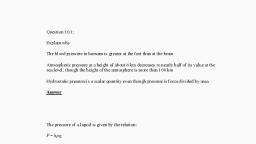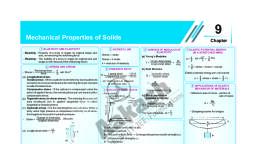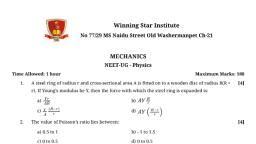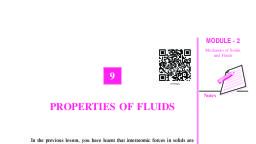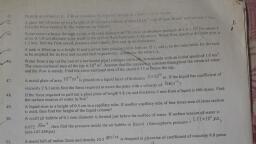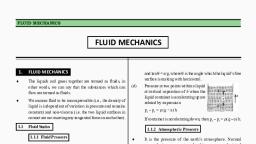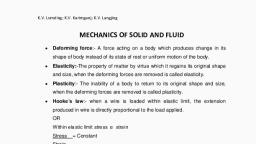Page 1 :
Mechanical properties of fluids 1, , 1 ERT): Sd, LEGENDS’ (MGDN) STUDY MATERIAL - | PUC PHYSICS (NC 1 body moving in 4,, , i : : herical, Derive an expression for terminal velocity of 2 SP, viscous medium., , . der gravity in a fluig, Consider a sphere of radius r and density p 5 ere. " :, density co. The following three forces act on the falling sphere., , _, , 5 ugh the, 1) Weight w of the sphere acting vertically downwards tapout F, centre of gravity of the sphere, 2) Upthrust U due-to buoyancy ard, 3) Viscous drag F acting upwards. u, “. Net downward force = w - (U + F) ---->(1), At the terminal velocity, the weight of the sphere is just ', , balanced by the sum of the upthrust and the viscous drag... There, is no resultant force on the sphere. Consequently, the sphere begins, to more with constant velocity called terminal velocity (vi)., , (1) > W-(F+U)=0, W=F+U, mg = F + U---->(2), But mass of the sphere, m = density of the sphere (p)xVolume of the sphere (V), , tis phat — 1g, From Stokes law, F = 6n 7 vi t----- >(4), , . 4, From Archimede’s principle, U= 3 6 g----- >(5), , . 4, Equations(3),(4) and (5) in (2)=> pame = 6nn vert Sarg g, , On simplification, we get,, , , , , , , , NOTE:, Ifp <o, then vr will be negative. In this Case, the body yw; s, reason that bubbles of air rise upward in water, _ ¥ will move upwards. It is for this, , , , Stokes’ law, Stoke’s law is givenby, F=6anrv, , where F is the viscous force acting on the sphericay body, y is co-efficient of viscosity of the liquia, ., ris the radius of the body,, , v is the terminal velocity of the body., , , , Scanned with CamSeanner
Page 2 :
aot) OLUDY MATERIA,, < L~I py, er mathemati C PHYSICS (N - i i, noth cal form of Sto (NCERT)-Mechanical properties of fluids 163, , . kes’ law, stokes’ law is also given by, put, 3p - 9) g, , , , , , where F = Viscous force, Pp = density of th ' °, - L © material of the t a, o = density of the liquid, sphere pA, 8 = acceleration due to gravity, a, r = radius of spherical body. ,, NOTE, iS 2 i ., toke’s law is applicable for spherical bodies only j :, , , , , , , , Reynold’s number, , It is a pure number which determines the type of flow of a liquid through a pipe., vpD, , n ,) ", v = speed of the liquid through a pipe, * as, p = density of the liquid,, D = diameter of the pipe,, y = coefficient of viscosity., , It is given by, Npr=, , , , Classification of nature of flow on the basis of Reynold’s number, Let Nr be the Reynold’s number, If Nr <.1000, the motion of liquid is streamline motion,, If Nr > 2000, the motion of liquid is turbulent motion,, If Nr is in between 1000 and 2000, the motion of liquid is unsteady ., , , , ADDITIONAL INFORMATION (For CET and understanding the subject), , Illustrations of Stokes’ law, , 1) Falling of raindrop, i der gral, When the:rain drops fall under gré rey ges, the viscous drag also increases. .Finally., , i ‘ drops 11) ‘ ji =, in air. As the ace el é ual to the effective force of gravity, The drops then, the dragging force, , th with uniform velocity. *, e ity and drop. to the ear, acquires terminal velocity, , , , , , , , , , vity, their motion is opposed by the viscous drag, , , , i hute ‘ flying aeroplane, he descends slowl, cending of parac’ te jumps from a flying plane, ends slowly, When a person with a ae ae In the beginning, the person falls freely with, air due to viscous drag decreases rapidly until the parachute is fully opened., , leration n increases somewhat rapidly and then very, , acceleratj , The acce j erso:, This is wi i speed of ei oe pe celeration of a person becomes zero. Then the, slowly. Due to viscosity OF eat terminal specd., , ‘ stant, Person falls. down with a con, , 2), , designed such that they experience least viscous drag by, €, , and cars am, , ) Aeroplanes poats wich they move- ; AN, , the fluid througt, ' J a, ” ‘, , Scanned with CamSeanner
Page 3 :
M SURFACE TENSION, olecular theory F, nied ee to the molecular theory, matter is made =p ‘of mage ciles,, forces. Th keep together due to molecular forces. There are two types of Molegy, similar me are cohesive force and adhesive force. The force of attraction between 4, molecules. cules is called cohesive force. Example: force of attraction betwee, watt, €s. The force’ of attraction between the dissimilar molecules is calleq adheg, , force. Example: i i . al :, ple: force of attraction between paper and ink molecules. The Cohesive tng, , is pi i, responsible for surface tension., , Pap lasted of surface energy, onsi ., the oa. oD ep nals, one (A) near the surface of a liquid and, kal a ewe mside the liquid as shown in the figure. The, Dae cee ens of the molecule A is completely surrounded, noe ecules of the liquid and hence the intermolecular, € Of attraction on this molecule is zero., , , , , , But th i , |, wiles asi ones re of the molecule A is partially in the liquid. The lower |, > the lig and the upper part is exposed to air. The force of attraction |, , oa, g, o, Q, 3, +, a, o, iad, aQ, c, i, a, 8, fe), 2, @, Q, c, a, o, >, Q, g, A, 3, 2, ®, Q, g, o, a, A, =m, oO, e, 6, S, 5, °, Oy, a, a,, o, a, a, co, io”, ©, is}, ot, >, o, rail, gs, 8, Ss, , ia, oO, 5, g, B, 2, o, 9, £, ic), a, a, 5, °, c, ga,, S., et, 8, g, 5, a, an, ce, >, ®, a, as, 5, °, ad, °, 8, ct, a, o, 5, a, oQ, a, °, 4, °, =, c, a, oO, 5, &, 5B, , the potential energy of the molecules lyi insi i, enero the leas on the sua of ef a els ec, at is, Surface energy (Es) « surface area of the liquid ao e, AX Where T is the Beppeaticaely — called : “ee, When the surface, area of the liquid is inereagerl oh hers pce |, surface increases and-hence potential energy of the system iner vt Molecules on the, A system remains in ‘stablé equilibrium, if the potential ae i ini, potential energy is minimum, if the surface area is minimum There oe es Me, stable equilibrium, the liquid minimizes its surface area. In other a, of the liquid behaves like a stretched membrane with a tendenc oetet B ise surface, volume, a sphere has the least surface area. “A small quent oe _ rach] ever, external forces always takes up a spherical shape. For example: rain dears precaeie, : , tiny d, , of mercury and water on a sheet of glass is spheri i i, equal to the surface tension. s 2 Cal. The surface energy is numerical, F \, , Define surface energy { ‘, It is the excess potential energy possessed by the mol ah, It can be shown that, olecules on the surface of the YG, , Surface energy « free surface area of the liquid > Es = TA, , where T is the surface tension of the liquid ae, , , , Scanned with CamSeanner
Page 4 :
Mechanical properties of fluids 165, , ne i, Tgy per unit area of free surface, , Surface tension, T= Es, , where Es is the Surface energy, , Alternate definition of, , ° Surface te, It is the tangential force Pp, imaginary line drawn, , and A is the area of the free surface of the liquid., nsion, e:, , on the liquid, , r Unit length acting normall i i, net 8 normally on either side of an, , Surface tension = Force, , , , , , , , , , , , , , , , , , , , , , =>T= E, Len 7, Angle of contact ath !, It is the angle between th, € tangent drawn to the liquid surface at the poi, : ae point of, contact and the solid surface with in the liquid. om, : seo, NOTE, rer = define Surface tension imagine a straight line AB drawn, on the free surface of the liquid. Due to the surface tension, a force is, acting perpendicular to the line on either side of the line. ‘The magnitude, of force per unit length is taken as measure of surface tension., What is surface tension? ;, Surface tension is the roperty of the liquid due to which the free surface of the liquid acts, Pp iq, like a stretched membrane, which tries to contract and occupy minimum surface area., 1) Surface tension is a vector quantity., 2) Its Slunitis Nm-! or Jm2 ‘, 3) Its dimensional formula is [ T ] = [M1L°T-2] : ee, 4) It decreases with increase in temperature and vanishes at critical temperature where the, surface vanishes due to the transformation of liquid to vapour. é, 5) Impurities such as, soap (Partially soluble in liquid), decreases the surface tension of the, liquids. This is because of less adhesive force between soap and liquid molecules, 6) I iti ch as salt and sugar (completely soluble in liquid), increases the surface, ie et a liquids. This is because of more adhesive force between impurities and, liquid molecules. we Ngs ial ict the tigui, 5 icant (Contamination) material particles on the quid surface, 7) ae dust parties’ ea on liquids. This is because of less adhesive force between, lecreases surfaci, them., Mercury, Water \, Angle of contanct : (Sis, = Glass Glass, i te (<90°) for concave meniscus. The liquids having acute angle, 1) The angle of contact nach aft in contact. The angle of contact between ordinary glass and, Wets the surfaces, W. . t 8°, ordinary water is acute. (It is S oitand <180°) for convex meniscus.. The liquid having, The angle of contact is Seat tie surfaces. The angle of contact between mercury and any, obtuse angle does not w «bout 135° ), surface is obtuse. (It ave any value between 0 and 180. ‘, 3 a angle . soc betweetl smooth glass surface and pure water is zero., keg “TE angle of con, , , , , , , , Scanned with CamSeanner
Page 5 :
EE MATERIAL = 1 PUC PHYSICS (NCERT)-Mechanical properties of fluids r, 6, Capillary tube: It is a tube of fine bore of uniform diameter. < =a, , Capillarity, , The rise or fall of the liquid from its free surface in the capillary tube dipped Partially j,, liquid is called the capillarity or capillarity action. a, , , , Capillary tube in water Capillary tube in mercury, Figure (1) Figure (2), , When a capillary tube is dipped in a liquid, the liquid rises up from free surface (In the, case of liquids, which wets the surface (Figure-1)) or depressed below the free surface (In the, case of liquids which does not wet the surface (Figure-2))., , The rise or fall of the liquid inside the tube depends on diameter of the tube. As the, diameter increase the rise or fall decreases as shown in the figures., , , , , , : Applications of surface tension, Formation of drops, , Due to the surface tension, a small, always takes up a spherical shape. The molecules lyi, , to the surface which balances the force due to, bubbles are spherical in shape due to surface tension., , NOTE, , Generally, for a liquid gas interface, the convex side has higher pressure than of concave sid¢:, , , , Expression for excess pressure for, , a concave surface towards air/rarer medium, Examples: Air bubbles and co:, , neave meniscus. Ro, , It is given by the formula, (P - P,)= 4— ae, . rr., , where P_ is the pressure inside the drop, a, , P, is the surrounding pressure and r is the radius of the drop., , ow, , , , Scanned with CamSeanner
